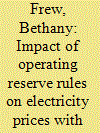| Srl | Item |
| 1 |
ID:
179685


|
|
|
|
|
| Summary/Abstract |
In competitive wholesale electricity markets, significant effort is devoted to designing markets that set efficient prices for maintaining supply-demand balance. One factor that can impact prices is administratively-set scarcity pricing, which sets prices to a preset level when the market is not able to meet operating reserve or energy requirements. When energy and operating reserves are co-optimized, assumptions surrounding operating reserve requirements and scarcity pricing can impact system-wide price outcomes for both operating reserves and energy. This study uses production cost modeling of an ERCOT-like system to evaluate the impact of operating reserve eligibility, scarcity pricing, and quantity rules on electricity prices, and therefore also on generator revenues. Results reveal economic and operational benefits with allowing open participation in reserve markets, as this enables greater access to the full set of capable resources at lowest cost. Furthermore, both energy and reserve prices are strongly impacted by reserve scarcity pricing events, which reveals that reserve scarcity pricing assumptions can impact price outcomes even for units not providing reserves. This study highlights the importance of operating reserve scarcity pricing rules because of the strong coupling between energy and reserve prices and because these rules serve as proxies for true price responsive demand.
|
|
|
|
|
|
|
|
|
|
|
|
|
|
|
|
| 2 |
ID:
099301


|
|
|
|
|
| Publication |
2010.
|
| Summary/Abstract |
In this paper, we analyze the current trend towards a higher degree of market integration in Europe and identify those aspects that are particularly relevant for Italy. The Italian involvement in this process appears comparatively modest. A welfare analysis, which focuses specifically on the integration of the Italian market, will certainly be a useful support to any policy decision. We argue that, given the peculiarities of the Italian market design, a volume coupling solution could avoid, at the moment, the costs of what could be a significant harmonization effort and, in the end, it might constitute the best short-term strategy. This proposal should be adequately considered, taking into account the complexity of designing an efficient volume-only coordination procedure.
|
|
|
|
|
|
|
|
|
|
|
|
|
|
|
|